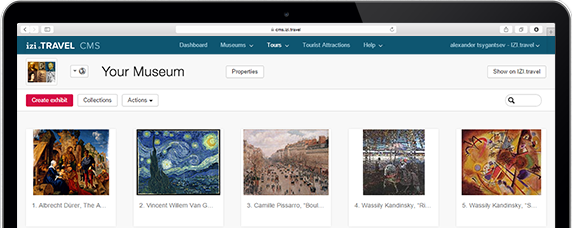Musée Natural History Museum Bern
- Download the applinks
- iOS
- Android
- Windows Phone
Infos Musée
À propos du musée
The IZI Travel App is being used to provide english and french exhibition texts to the visitors. There are currently no audio guides available.
The Natural History Museum Bern was officially founded in 1832. In 1936 it moved into a new building in Bernastrasse deemed an excellent example of the "Neue Sachlichkeit" style. The building was extended in 1998. The museum has 5100 square metres of exhibition space and an international reputation founded initially on its historical dioramas. Aside from Barry, the NMBE is famous for housing the giant Planggenstock crystals and for outstanding contemporary exhibitions such as the prize-winning "c’est la vie". The museum's collection contains around 4 million objects. The Naturhistorisches Museum Bern is also a place of research conducted by the 22 scientists responsible for the collections, and functions as a venue for cultural events - most recently the "Help, it's alive!" series and the "Dead animal bar".
The IZI Travel App is being used to provide english and french exhibition texts to the visitors. There are currently no audio guides available.
Programmer votre visite


- Musée d'histoire naturelle de Berne, 15, Bernastrasse, Dalmazi, Kirchenfeld, Stadtteil IV, Berne, Arrondissement administratif de Berne-Mittelland, Région administrative de Berne-Mittelland, Berne, 3005, Suisse
- http://www.nmbe.ch
Pièces exposées
Objets exposés présentés avec fichier audio
-
Mortal remains
-
Barry of the Great St. Bernard
-
Barry in the Museum
-
Sanctuary in the wilderness
-
Here Christ is adored and nourished
-
Shelter from the world outside
-
The hospice on the Great St. Bernard pass.
-
Witness to history: the hospice’s rst visitors’ book, dating from 1812-18. Jahren 1812-18
-
Trusty Barry, cask at the ready
-
Encased in concrete
-
Rescuers on four paws
-
The work of the hospice dogs
-
Just a nice idea
-
Early mountain rescuers
-
Barry – hero or helper?
-
A miraculous rescue?
-
Barry carries a child to the hospice
-
Being a hero
-
From dog to national hero
-
Barry’s transformation
-
A motley crew
-
A question of identity
-
Some truth – and a lot of legend
-
Barry’s tragic death
-
Old fears and new perils
-
Ordinary people on a dangerous journey
-
Barry and Napoleon
-
A taste of things to come
-
Matter of honour
-
Lucky finders
-
The mineral inventory
-
The Rolls-Royce on the ceiling
-
Sweet and colourful
-
Coveted crystals
-
Quartz – part of human history
-
Mysterious powers?
-
Royal regalia
-
How did the crystals get into the cleft?
-
Crystals and life
-
Live at the origin of mountains
-
Crystal planet
-
The structure of the Earth
-
Extraordinarily ordinary
-
Neat and tidy
-
Crystal clefts in granite
-
Room 1 The Only Certainty
-
Room 2 The End Is Always Near
-
Room 4 Death Rules
-
Room 5 Living It Up
-
Room 7 An Open Ending
-
Room 3 Endangered Earth 1/3
-
Room 3 Endangered Earth 2/3
-
Room 3 Endangered Earth 3/3
-
Room 6 A World out of Kilter 1/2
-
Room 6 A World out of Kilter 2/2
-
Guest star - Noviaster polyplax
-
3 for 2!
-
5 stars - Sensational fossil discovery in the Jura Mountains
-
Veterans of the sea
-
Just like the Bahamas?
-
One piece of the discovery
-
Video
-
Discovery from 2016 - Hauptrogenstein
-
Cabinet of Curiosities – the display Collection
-
Why do we need collections?
-
Life’s secrets revealed in death
-
Preserving for eternity
-
Swiss fish – endangered diversity?
-
Understanding and protecting biodiversity
-
Recording losses
-
Black widow toad
-
”ugly brown frogs”
-
Making cryptic diversity visible
-
A discovery on our doorstep
-
Collections are useful
-
The venom cocktails
-
Collecting insects
-
Collection of bird’s eyes and brains
-
What is a puppy doing here?
-
Native bats
-
DNA extraction
-
Pigments in this frog’s skin
-
Collections and the ravages of time
-
Professionally preserved in the 1920s
-
Steinmann-Eawag collection: A window into past diversity
-
Documenting the loss
-
Priceless rarities
-
Projet Lac and Progetto Fiumi: a modern inventory of Swiss fish species
-
Museum’s reference collection consists of up to 30 individuals
-
Genetic analyses
-
Swiss fish diversity: A complex matter with many unknowns
-
The “whitefish fillet”
-
The Lake Constance deep water char
-
Summer temperatures
-
Fishes in Switzerland are endangered
-
The sea lamprey
Commentaires
2 avis
Évaluer cette visite-
07-30-2022
Emocionante recorrido, pasillos llenos de naturaleza. Impresionante y recomendable
-
02-17-2018
Un musée magnifique et très varié, un trésor pour les enfants
Téléchargez l'appli gratuite izi.TRAVEL
Créez vos propres visites audio!
L'utilisation du système et de l'appli de guide mobile est totalement gratuite

